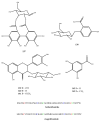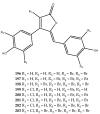Natural Bioactive Compounds from Marine Invertebrates That Modulate Key Targets Implicated in the Onset of Type 2 Diabetes Mellitus (T2DM) and Its Complications
- PMID: 37765290
- PMCID: PMC10538088
- DOI: 10.3390/pharmaceutics15092321
Natural Bioactive Compounds from Marine Invertebrates That Modulate Key Targets Implicated in the Onset of Type 2 Diabetes Mellitus (T2DM) and Its Complications
Abstract
Background: Type 2 diabetes mellitus (T2DM) is an ongoing, risky, and costly health problem that therefore always requires new treatment options. Moreover, although several drugs are available, only 36% of patients achieve glycaemic control, and patient adherence is a major obstacle. With monotherapy, T2DM and its comorbidities/complications often cannot be managed, and the concurrent administration of several hypoglycaemic drugs is required, which increases the risk of side effects. In fact, despite the efficacy of the drugs currently on the market, they generally come with serious side effects. Therefore, scientific research must always be active in the discovery of new therapeutic agents.
Discussion: The present review highlights some of the recent discoveries regarding marine natural products that can modulate the various targets that have been identified as crucial in the establishment of T2DM disease and its complications, with a focus on the compounds isolated from marine invertebrates. The activities of these metabolites are illustrated and discussed.
Objectives: The paper aims to capture the relevant evidence of the great chemical diversity of marine natural products as a key tool that can advance understanding in the T2DM research field, as well as in antidiabetic drug discovery. The variety of chemical scaffolds highlighted by the natural hits provides not only a source of chemical probes for the study of specific targets involved in the onset of T2DM, but is also a helpful tool for the development of drugs that are capable of acting via novel mechanisms. Thus, it lays the foundation for the design of multiple ligands that can overcome the drawbacks of polypharmacology.
Keywords: diabetes mellitus; drug discovery; enzymatic targets; marine invertebrates; marine natural products; metabolic diseases.
Conflict of interest statement
The authors declare no conflict of interest.
Figures













































References
-
- World Health Organization. [(accessed on 17 July 2023)]. Available online: https://www.who.int/health-topics/diabetes#tab=tab_1.
Publication types
LinkOut - more resources
Full Text Sources

